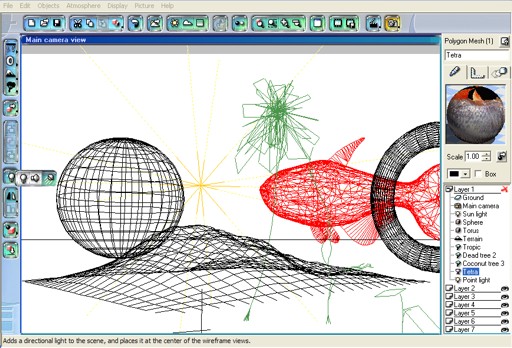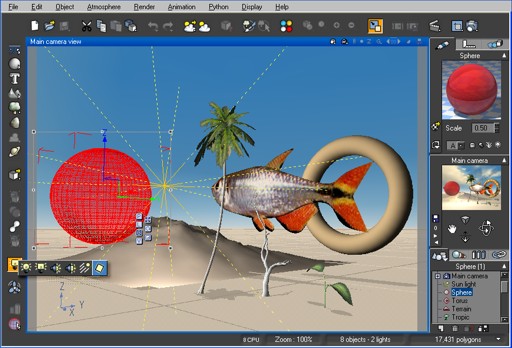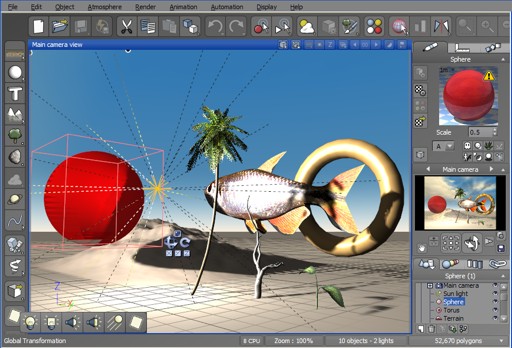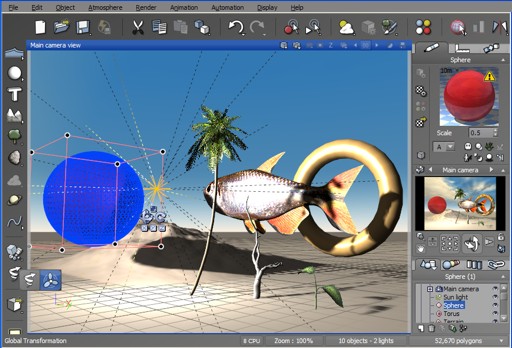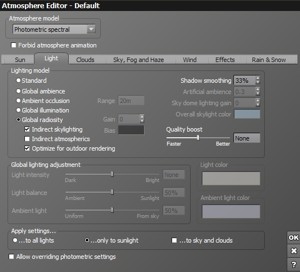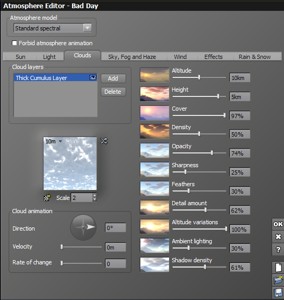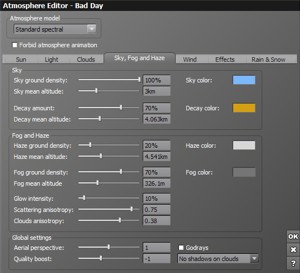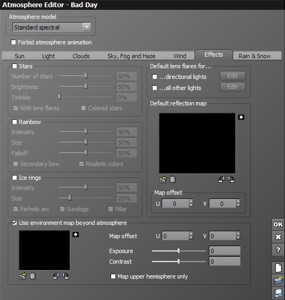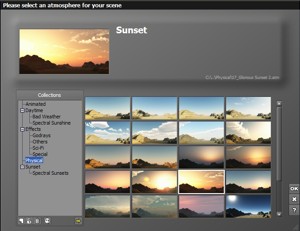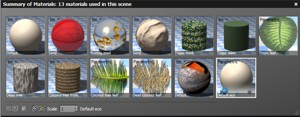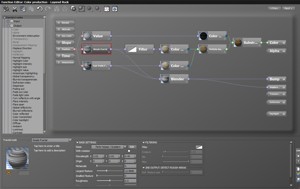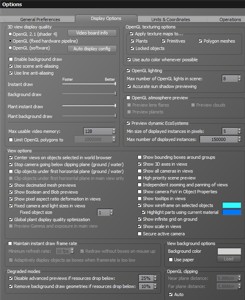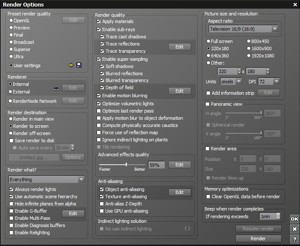Vue d'Esprit & co. (Infinite, xStream, Complete, Easel etc...)
Introduction
Vue d'Esprit means in french "a view from the mind/soul".
Main purpose of Vue is creation & rendering of natural looking
3D
environments in 3D.
Vue provides tools facilitating generation of 3D terrains (mountains,
dunes, rocks...) and spread of 3D objects instances (vegetation, stones...).
Thus it is easy to generate mountains covered by forests or dunes emerging
from fields of stones and so on. Over such scenes user can define skies with
various cloud layers & atmospheric effects.
Vue lack general purose modeling tools, so objects like houses, cars,
characters must be imported into Vue scenes.
Vue is developed by French IT company e-on software SARL from Paris, and is sold in 11 'flavors' starting from 1700$ full-featured xStream, through hobbyst graded 600$ Complete, to free Pioneer depleted from most features. All versions base on the same Vue xStream code & interface, but cheaper is a versions, more features are blocked.
Vue is mainly used by hobbyists, but since Vue 4 Pro release in 2003 e-on tries to attract 3D professionals and some film industry artists have used Vue to create backgrounds scenes (matte painting) and concept art for big budget productions.
History
Current Vue family has evolved from Vue d'Esprit developed from 1992 by Nicholas Phelps, the founder and owner of e-on software company. Nicholas Phelps was directly involved in Vue d'Esprit programming till version 4. Later versions coding was carried on by hired programmers.
Vue timeline
| 1992 | Nicholas Phelps writes first lines of code |
| 1994 | First version is ready, but since rendering requires manual tweaking of configuration files, it is not yet ready to be released in public. |
| 1995 | Vue d'Esprit 1.2 (15$) is
released on 2 1.44MB floppies. It generates fractal terrain, sky, cloud & water planes. |
| 1997 | Vue d'Esprit 2 is released
(130$) on CD by newly founded e-on software SARL. It supports multiple terrains, vegetation & imported objects. |
| 1999 | Vue d'Esprit 3 (220$) &
animation tool Mover are released. Poser import, soft shadows, faster rendering. |
| 2001 | Vue d'Esprit 4 (200$) is released, also for Mac |
| 2003 | Vue 4 Professional aimed at CG professionals is released |
| 2005 | Vue 5 is released in numerous versions (Easel, Esprit, Pro Studio, Infinite, xStream for 3DS Max & Maya). Ecosystems instancing system gives Vue technological edge and boosts its popularity. New graph based function editor & radiosity lighting. |
| 2006 | For the first time Vue is used in a big movie production Pirates of the Caribbean 2 to generate background scenes (forest covered mountains) |
| 2007 | Vue 6 is released, xStream expands to Lightwave, Cinema4D, XSI and EcoSystems painter allows to scatter objects instances with mouse strokes. |
| 2008 | Vue 7 release marks begining of frequent (twice a year) releases of new versions. Now users have to pay for 1/2 versions. |
| 2013 | Vue 11 is released and it can use plants created in new Plant Factory editor (sold separately) |
| 2014 | Vue 12.5 (2014.5) is the first free 1/2 update since 6.5, but unfortunately it removes some substantial functionality from Plant Editor. (read more) |
First versions of Vue d'Esprit were simple and cheap - this made them
attractive to hobbyists who couldn't afford to spent thousands $ on professional
3D software.
Vue d'Esprit had a straightforward, intuitive interface from which
basic functionality could be deduced in matter of minutes. Such thrill-free
approach to 3D scenery creation was very appealing for amateur artists looking
for nice results without the need to study 1000+ pages manuals typical to
high-end 3D applications.
Success
In 2004 e-on have launched expensive (600$) Vue 4.5 Professional. "Professional" name was intended to broke a stereotype that Vue d'Esprit is just an amateur grade application. With 5th release Professional was rebranded as Infinite. Since then e-on focused more and more on professional market, while for hobbyists it continued releasing cheaper versions depleted of functionality.
The most dynamic & fruitful development of Vue took place between
2000-2006.
The same period was rather a bad time for its main competitor Bryce,
which changed ownership and got very little improvements. When Vue 5
was released in 2005 its functionality significantly outstripped Bryce,
reducing it to a low-end toy for amateurs. Since then Vue has become
more popular among hobbyist artists than Bryce.
e-on innovative approach to define instancing inside material & painted EcoSystems give Vue 5 technological edge, and let Vue being used in several large film productions like "Pirates of the Caribbean 2" (backgrounds: vegetation covered terrains and skies).
Problems :
Bugs: Vue was always hampered by stability problems. From my own experience, it was a lucky day when it crashed just twice. Often several crashes per hour happens and numerous other bugs annoy users with faulty functionality. It causes the lost of confidence among 3D community, which considers Vue to be a buggy, unreliable software. It is still possible to work with Vue, but frequent saving of scenes is nedded to not loose too much work if a crash happens.
Frequent releases: e-on decision to multiply frequency of releases was quite misfortunate because faster peace didn't translate on more features or functionality, just increased costs for customers. At the turn of century, new versions have been released after several years of development (ex. 4 years between Vue 4 and 5). Then customers switching to next version got substantial improvements. When releases cycle was shortened to 6 months quantity of new features dropped. Such inflation of new versions reduced customers interest to purchase every new version.
Ergonomics: With each new release Vue got more features, and
became more complex. Strategy to release Vue in numerous versions (infinite,
esprit, complete., etc...) backlashed in problems with interface design. Interface
items instead of being put according to logics and ergonomics, had to be placed
where it was easily to remove them from cheaper versions. This resulted in
gradual loss of original Vue advantage of simplicity and ease of use.
Also to get decent results with Vue, it is necessary to master graph
based function editor, which is often beyond abilities of most users.
Getting outdated: Vue still uses old biased CPU render and materials system is outdated. As result Vue renders are slow and usually have a "cheap" look which can't compete in realism with leading studio-grade renderers like Octane.. e-on also kept old Vue 2 content mixed up with newer content. Old content often is incompatible with new features (ex. old materials and new photometric lighting & gamma), and spoils appearence of scenes made by unaware users.
Now 3D professionals complain on poor reliability of Vue & low
quality of renderings, while hobbyists on high prices and low value of new
features. Those are major factors behind current slow drop of Vue popularity.
Future :
What is the future for Vue? Unless a lot of effort is put into catching up with leading 3D technologies, Vue may end up like Bryce, used by a handfull of ardent fans. However spending dozens of millions $ may never pay off, as it was the case with EOVIA's Carrara. Considering Autodesk infamous decision to end the development of legendary Softimage, it seems that professional 3D market is saturated now.
Vue has arrived on 3D scene quite late. Other 3D packages started to establish their position on the marked 10 years before Vue was released. As a small newcomer e-on had no resources to develop Vue into another full 3D package like Maya or XSI, so it decided to find a relatively empty niche of 3D natural environments, where it could compete with small players like Bryce, Terragen, MojoWorld.
Despite increasing complexity of the interface and problems with bugs, Vue
is today the best featured application focused on generation of 3D landscapes
:
Bryce technology
is years behind Vue, it is no longer developed, and is distributed
by DAZ3D for 20$. Terragen
can produce very nice terrains and skies, but since version 2 it uses a very
complex graph based interface, incomprehensive for average hobbyist.
MojoWorld
seems dead since several years. World
Machine can create nicer terrains with very realistic erosion, but it
can't do anything else and is also very buggy.
The question remains if what Vue focuses on still makes any sense in a separate application? Big 3D applications gradually incorporated into their toolset most of Vue functionality - skies, clouds, instantiation, vegetation, 3D sculpting, so today they can do the same or better as Vue does. Also using an external application like Vue to generate enviromnemt creates a lot of problems when you need to merge it with your scene created in main application (ex. Maya). In theory xStream plugin should do the job, but it never worked for me (I tested C4D version only, I don't know if it is better for other apps.)
Also there is a more trivial question : what is the point to synthesize in
3D what mother nature does since eons? Nature does it better, faster and nicer
than any 3D software.
It is enough to take a camera and shoot nature outside. No 3D imagery can
match what we find in nature. If you don't agree, check this movie : HOME,
and try to recreate one of scenes in 3D. Of course there are situations when
we need some unusual or alien environments we can't find on Earth - then 3D
environments make sense.
So maybe there is still some bright future for Vue.
Good luck Vue !
Modeling in Vue :
Vue lacks most classic modeling features typical to full 3D packages like 3DMAX or Maya, but you can still do in Vue some modeling using following tools:
- Primitives
- eXqüp
- Metablobs
- Terrain sculpting
- Text Editor
- Plant Editor
Primitives are simple geometric shapes: hexagon, sphere, torus, cone, cylinder, pyramid. It is possible to stretch those figures in all directions and perform on them Boolean operations (difference, intersection, union), as well as automated multiplication/scattering. Below is an example of objects I have modeled in Vue from primitives with Boolean operations.
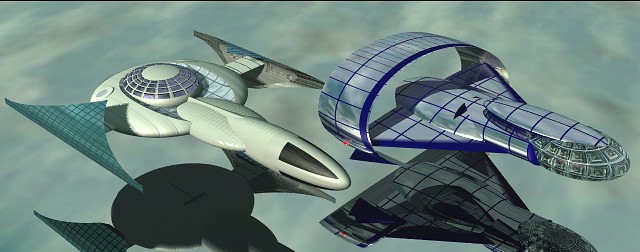 Both
space ships were modeled in Vue 4 from simple geometric figures (primitives).
Both
space ships were modeled in Vue 4 from simple geometric figures (primitives).
It is possible to create a lot of "mechanical" objects with primitives - problems arise when we need to model freely a surface (ex. body of a car). In Vue it is rather impossible. You heave to model your object ouside Vue, using a dedicated 3D modeling program and then try to import it into Vue.
eXqüp (Exquisite Über Primitives) is a tool which provides procedural modeling power from The Plant Factory (TPF) within Vue Plant Editor, so it is possible to create directly in Vue objects like those below:
 Click
on image for more information about eXqüp
Click
on image for more information about eXqüp
Metablobs are "melted primitives". All Vue primitives may be "metablobed" - such object has rounded edges and its elastic skin melts with other metablobs. Thanks to metablob you can easily simulate lava lamp or even create organic characters
Terrains are special objects that are mainly used to simulate natural landscapes, but can be used for much more. Terrains base their altitude on elevation map (bitmap or procedural). It allows you to create also all kinds of "die casted" objects, and joining them together you can quickly get very complicated 3D objects.
 Everything
on this image is terrain - main terrain is procedural, objects are double
terrains, and city is standard terrain.
Everything
on this image is terrain - main terrain is procedural, objects are double
terrains, and city is standard terrain.
Recent versions of Vue add some 3D sculpting capability on top of elevation map modeling for terrains. 3D sculpting of terrains is by no means as what offers ZBrush, Mudbox or even Sculptris, but for terrain only purpose it is an useful addition.
Text editor allows to type 3D text to your scenes and thanks to numerous options of extrusion & beveling of characters, it is possible to obtain some unusual shapes :
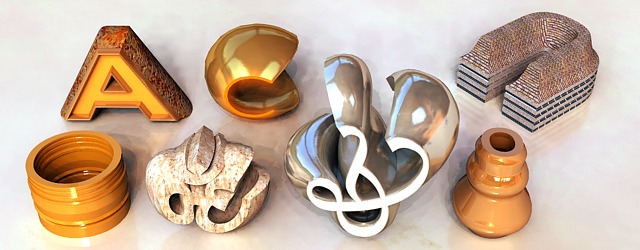 A
few examples of "text" obtained from Vue Text editor - each object
us a unique letter - extruded and beveled
A
few examples of "text" obtained from Vue Text editor - each object
us a unique letter - extruded and beveled
Plant editor - allows to modify existing models of plants. For old Solid Growth plants it provides a predefined set of controls, for new TPF plants additional published parameters controls are available.
Instancing - EcoSystems :
Vue "EcoSystems" instancing was legendary, one of first on the market, and still without competition in some aspectss. It allows to cover your scenes with countless instances of trees, plants rocks and other object. It remains the most cool 3D feature of Vue. Instances placement on the scene can be managed by material, hand painted or follow a spline.
Vue plants & rocks can have variability incorporated at design stage. If this is the case, such item placed into EcoSystem will display such variability (ex. younger, older, with more or less branches etc...). However this system is rather limited. There are always 8 variants of item generated for EcoSystem, and user has no control over such automatically generated variants - if a variant looks bad, there is no way to remove it from EcoSystem or regenerate a new one. Also you can't define number of variants - always you get just 8.
Atmosphere & Lighting :
Lighting of scenes was very easy in early versions of Vue. You just
loaded a preset of atmosphere and repositioned the sun if needed. However
with introduction of gamma settings and various atmosphere models (like photometric),
it become more challenging for less advanced users to obtain proper scene
lighting.
Global ilumination uses automated settings allowing less advanced users to
create nicely light scenes without going into technical details of GI. (manual
GI setting is possible)
Old style cloud layers are just infinite planes with procedural material transparency,
they are pretty fast to render and usually produce nice fuzzy high altitude
clouds. New volumetric clouds are rendered in 3D, but in most cases they lack
realism and are extremely slow to render (single HD image can take many hours
to complete) and rendering time increases expotentially with image size. So
usually volumetric clouds are just "no go". It is beter to use a
background HDR photo of real clouds than render volumetric ones.
Particles system :
Vue has a particle system, but I haven't used it yet, so I can't comment
on its efficiency.
I'll update this chapter after I do some tests with particles.
Summary :
Vue was optimized for landscape creation. It interface still remains
quite easy to master on basic level, but to obtain good looking images it
is necessary to master pretty complex graph based function editor, which often
is too much for less advanced users.
Vue comes with extensive libraries of content (atmospheres, materials, vegetation,
rocks, terrains) Unfortunately good quality content is mixed up with old one,
so sometime it can be tricky to select nice & compatible elements. If
you are not daunted by crashes, you can still create interesting imagery with
Vue, especially if it is done for fun.

